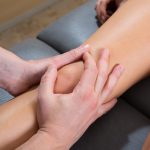This week’s health news roundup contains stories about Crohn’s disease, knee pain, fibromyalgia, rheumatoid arthritis, and irritable bowel syndrome (IBS). This week, we looked at Crohn’s disease and vitamin D deficiencies, causes and home remedies for knee pain at night, and much more.
In case you missed any of these top health stories, we have compiled them together for your peruse.
 Crohn’s disease causes vitamin D deficiency, inflammation may be reduced by raising vitamin D levels: Study
Crohn’s disease causes vitamin D deficiency, inflammation may be reduced by raising vitamin D levels: Study
Advertisement
Crohn’s disease (CD) causes vitamin D deficiency, so inflammation may be reduced by raising vitamin D levels. Researchers from Boston University School of Medicine found that vitamin D absorption in Crohn’s disease patients is reduced, which results in a deficiency. The only way to determine vitamin D absorption in Crohn’s disease is with a vitamin D bioavailability test.
Vitamin D can be sourced through food, but it is primarily synthesized in the skin through UVB exposure. People who live in areas with low sunlight exposure have higher rates of vitamin D deficiency, along with higher rates of inflammatory bowel disease (IBD).
The researchers looked at 10 healthy participants along with 37 Crohn’s disease patients. Vitamin D bioavailability tests were conducted on all subjects. After blood was drawn, each participant was given 50,000 IU oral dose of vitamin D2 and had their blood drawn again after 12 hours. The researchers found that Crohn’s patients on average had 30 percent reduced ability to absorb vitamin D2, compared to the normal subjects.
The study affirms the importance of a vitamin D absorption test. Lead author Francis Farraye explained, “We demonstrated that neither disease activity nor prior surgery or location of disease predicts the ability to absorb vitamin D.”
Senior author Michael Holick added, “Since the ability to absorb vitamin D in Crohn’s disease patients is unpredictable, the only way to determine absorption efficiency is to perform a vitamin D bioavailability test. This test is convenient and its use may guide clinicians in administering the appropriate therapeutic dose of vitamin D for treating vitamin D deficiency in patients with Crohn’s disease.”
Farraye concluded, “Our data support the use of an oral vitamin D absorption test in CD patients, especially in those patients who could not correct in the vitamin D deficiency by either dietary or pharmacologic means.” Continue reading…
 Knee pain at night, causes and home remedies
Knee pain at night, causes and home remedies
Knee pain at night is a common problem, as by the time the night falls and you finally lay to rest, the day’s activities finally catch up to you, causing worsened knee pain. Nightly knee pain can keep you awake, disturbing your sleep and thus causing even greater health problems.
The likelihood of experiencing knee pain at night grows with age. Nighttime pain is also commonly seen in overweight or obese individuals, or those put an added stress on the knee through strenuous activities.
To better understand knee pain at night, we will outline the common causes and share how you can treat knee pain at night from the comfort of your own home. Continue reading…
 Fibromyalgia pain eased with lidocaine painkiller injection and Lyrica drug: Studies
Fibromyalgia pain eased with lidocaine painkiller injection and Lyrica drug: Studies
Fibromyalgia pain can be eased with lidocaine painkiller injection and Lyrica drug, according to research. Fibromyalgia is a condition characterized by widespread musculoskeletal pain and a heightened sensitivity to pain. Because it does not have a clear-cut cause, fibromyalgia is quite challenging to treat.
The study revealed that injecting lidocaine into peripheral tissues could effectively reduce pain sensitivity.
Lead author Dr. Roland Staud said, “We hypothesized that if pain comes from the peripheral tissues, and we can take this pain away by injecting local anesthetics, then this would be indirect proof of the importance of peripheral tissues for the clinical pain of these individuals. Over-the-counter medications and [narcotic] prescriptions such as opiates aren’t really effective for controlling chronic pain conditions. [But with the new therapy] we are able to explain the pain of chronic patients better and manage it better. We’re making progress but it will take time.”
The study involved 62 women with fibromyalgia. Each woman received four injections: two in certain muscles in their shoulders and two in their buttocks. Some women received lidocaine, whereas others – the control group – received saline solutions.
After the injections, pain stimulations were administered to the subjects. The women in the lidocaine group experienced lesser pain than those in the saline group, but both groups did experience lesser pain.
Michael Robinson, director of the University of Florida Center for Pain Research and Behavioral Health, said, “The best way to treat chronic pain conditions is… [by] looking at emotional, sensory, and tissue damage. We know there are central and peripheral and social and behavioral components to someone saying, ‘Ow, it hurts’.”
Dr. Houman Danesh, director of integrative pain management at Mount Sinai Hospital, commented on the study, “It is interesting to note that the points which were used were acupuncture points, therefore suggesting acupuncture as a possible treatment to help patients with fibromyalgia.” Continue reading…
 Rheumatoid arthritis risk in women may be reduced through breastfeeding: Study
Rheumatoid arthritis risk in women may be reduced through breastfeeding: Study
Rheumatoid arthritis risk in women may be reduced through breastfeeding, according to research. The study, which included over 7,000 older Chinese women, found that breastfeeding was associated with a reduced risk of rheumatoid arthritis. The risk was cut by half, compared to women who never breastfed.
It has been long known that breastfeeding offers numerous benefits to both mother and child, but previous research has come up with mixed conclusions on breastfeeding and rheumatoid arthritis (RA). This time, researchers completed a cross-sectional study to assess the relationship between rheumatoid arthritis, breastfeeding, and the use of oral contraceptives.
The researchers used data from 7,349 older Chinese women over the age of 50. The women answered questionnaires pertaining to their sociodemographic history, disease and lifestyle history, obstetric history, breastfeeding history, and history of oral contraceptive use. The women were also asked whether they had been diagnosed with rheumatoid arthritis and were inspected by trained nurses for any swelling or tenderness.
The majority of women had at least one live birth and 95 percent of those women breastfed for at least a month. Only 11 percent of women used oral contraceptives, and the mean age for rheumatoid arthritis diagnosis was 47.5.
The researchers found in women who had at least one live birth, breastfeeding reduced their risk of rheumatoid arthritis by half. Rheumatoid arthritis risk was further reduced by the duration of breastfeeding. No correlation was found between the use of oral contraceptives and the risk of rheumatoid arthritis.
The researchers concluded, “Women who took part in this study were born in the 1940s and 1950s, before China’s one-child policy was introduced in the late 1970s, and at a time when breastfeeding was more prevalent. The consequent decline in breastfeeding supports the need for prospective studies to examine whether there will be a higher incidence of RA in the future. More importantly, replication of the association between breastfeeding and lower risk of RA in a different population reinforces the need for further research to understand the hormonal mechanisms involved in the onset of RA.” Continue reading…
 Irritable bowel syndrome (IBS) symptoms can be reduced with exercise, physical activity
Irritable bowel syndrome (IBS) symptoms can be reduced with exercise, physical activity
Irritable bowel syndrome (IBS) symptoms can be reduced with exercise and physical activity. The findings come from the University of Gothenburg’s study, which included 102 patients. Half of the patients were randomly selected to increase their physical activity levels, while the other half maintained their usual lifestyle.
Both groups received supportive phone calls from physiotherapists.
Advertisement
The active group increased their physical activity independently, with the advice and support of a physiotherapist. Author and registered physiotherapist Elisabet Johannesson said, “They were advised to perform moderate to vigorous physical activity for 20 to 30 minutes three to five times a week.”
At the beginning of the study and after three months, all participants were asked to rate their IBS complaints. Senior physician responsible for the study Riadh Sadik explained, “The group with unchanged lifestyle had an average decrease of symptoms by five points. The active group, on the other hand, showed a symptom improvement with an average reduction of 51 points.”
Those in the unchanged lifestyle group had deteriorating symptoms by 23 percent, compared to only eight percent of those in the increase physical activity group. Sadik concluded, “This suggests that even a slight increase of physical activity may reduce symptoms and protect from deterioration.” Continue reading…
